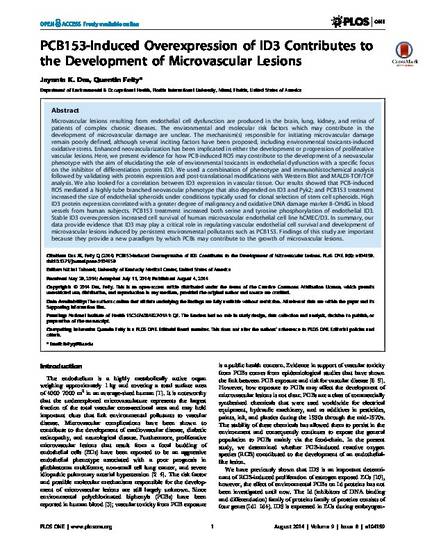
Microvascular lesions resulting from endothelial cell dysfunction are produced in the brain, lung, kidney, and retina of patients of complex chronic diseases. The environmental and molecular risk factors which may contribute in the development of microvascular damage are unclear. The mechanism(s) responsible for initiating microvascular damage remain poorly defined, although several inciting factors have been proposed, including environmental toxicants-induced oxidative stress. Enhanced neovascularization has been implicated in either the development or progression of proliferative vascular lesions. Here, we present evidence for how PCB-induced ROS may contribute to the development of a neovascular phenotype with the aim of elucidating the role of environmental toxicants in endothelial dysfunction with a specific focus on the inhibitor of differentiation protein ID3. We used a combination of phenotype and immunohistochemical analysis followed by validating with protein expression and post-translational modifications with Western Blot and MALDI-TOF/TOF analysis. We also looked for a correlation between ID3 expression in vascular tissue. Our results showed that PCB-induced ROS mediated a highly tube branched neovascular phenotype that also depended on ID3 and Pyk2; and PCB153 treatment increased the size of endothelial spheroids under conditions typically used for clonal selection of stem cell spheroids. High ID3 protein expression correlated with a greater degree of malignancy and oxidative DNA damage marker 8-OHdG in blood vessels from human subjects. PCB153 treatment increased both serine and tyrosine phosphorylation of endothelial ID3. Stable ID3 overexpression increased cell survival of human microvascular endothelial cell line hCMEC/D3. In summary, our data provide evidence that ID3 may play a critical role in regulating vascular endothelial cell survival and development of microvascular lesions induced by persistent environmental pollutants such as PCB153. Findings of this study are important because they provide a new paradigm by which PCBs may contribute to the growth of microvascular lesions.

Originally published in PLoS One.